The drama of weather: Back in February, I was resigned to the rainy season having ended prematurely. There had been no significant rain since Christmas. I started watering some vegetables and fruit trees. And then we got a nice storm on February 22, George Washington’s birthday. And then another storm arrived in early March, and then another, and another.
Yes, March can be rainy, but it’s not usually that rainy. For example, in Los Angeles, as measured on the campus of USC, precipitation averages 2.43 inches in March but this year received 4.35 inches.
Today is April 10, and it has been raining for the last five days straight. My rain gauge says my yard has received over five inches from this storm alone, and I am listening to the rain continue to fall as I write. (Update: We ended up getting a total of 6.16 inches.)
Today’s neverending storm has broken records. The daily precipitation record for yesterday, April 9, was set by a storm in 1912 for Riverside, but this storm broke it, as Riverside recorded 0.71 inches yesterday. That same 1912 storm set the daily record for San Diego, but San Diego broke it and recorded 1.16 inches for the day, yesterday.
As far as the whole month of April goes, the average precipitation for Los Angeles (USC) is only 0.91 inches — less than one inch for the whole month — so clearly this weather is not our norm.
What a gift though, right? What are the effects of this wet (and therefore, cool) start to spring on our gardens? Some are obvious, some less so. And surely, others will reveal themselves only over the next few weeks and months.
Super weeds
Walking in the University Heights neighborhood of San Diego yesterday, I noticed thistles and crab grass exploding out of every crack in the sidewalk. In my own yard, winter weeds like filaree continue to germinate and grow fast. It seems that as soon as I mow or run the chicken pen across an area, the pasture has replaced itself the very next day. At least the honeybees like the flowers of the whitestem filaree (Erodium moschatum).
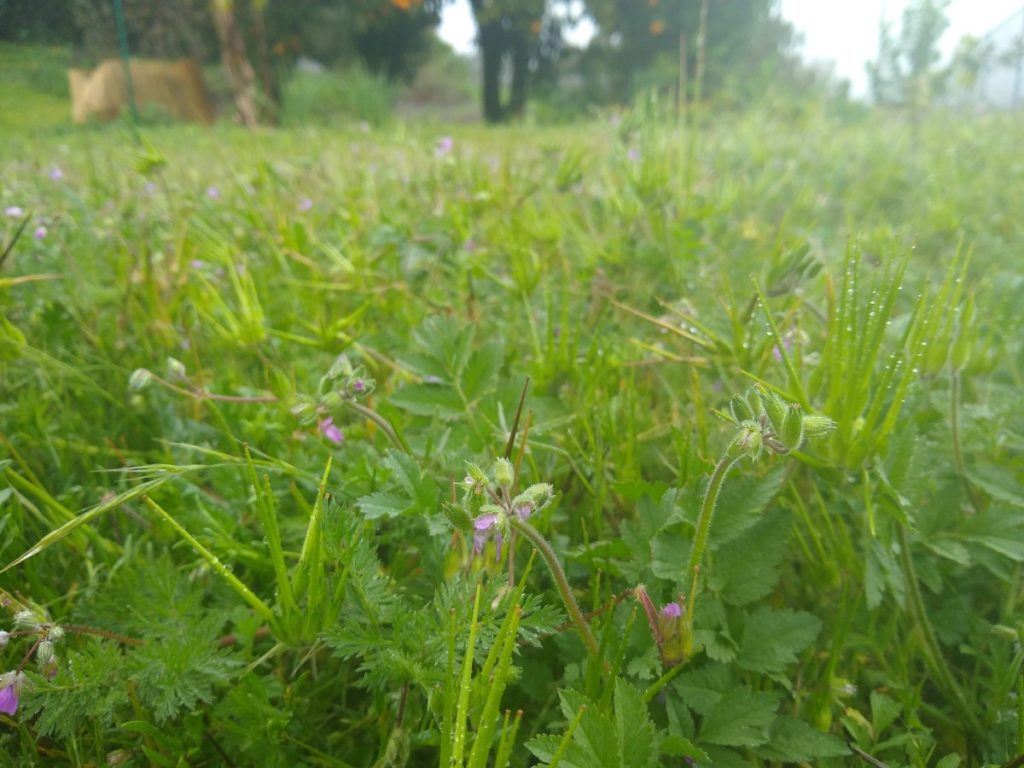
Super wildflowers
Also, the other flowers that grow naturally and those I’ve specifically planted for the bees are growing exceptionally well, and some have started to bloom, such as borage, tansy phacelia, and poppies. I made a video about these ones last week.
Stalled avocado bloom
On the other hand, the flowering of avocados has stalled. Usually, April is the month of peak bloom for most avocados. But this year, many trees have either stalled in the early stages of their flowering or have not yet even started.
My avocados always bloom a bit later than trees in most other parts of Southern California, but never has it been this delayed. Here on April 10, my avocado trees have barely opened a few flowers, and those are only on the early varieties of Pinkerton and Fuerte.
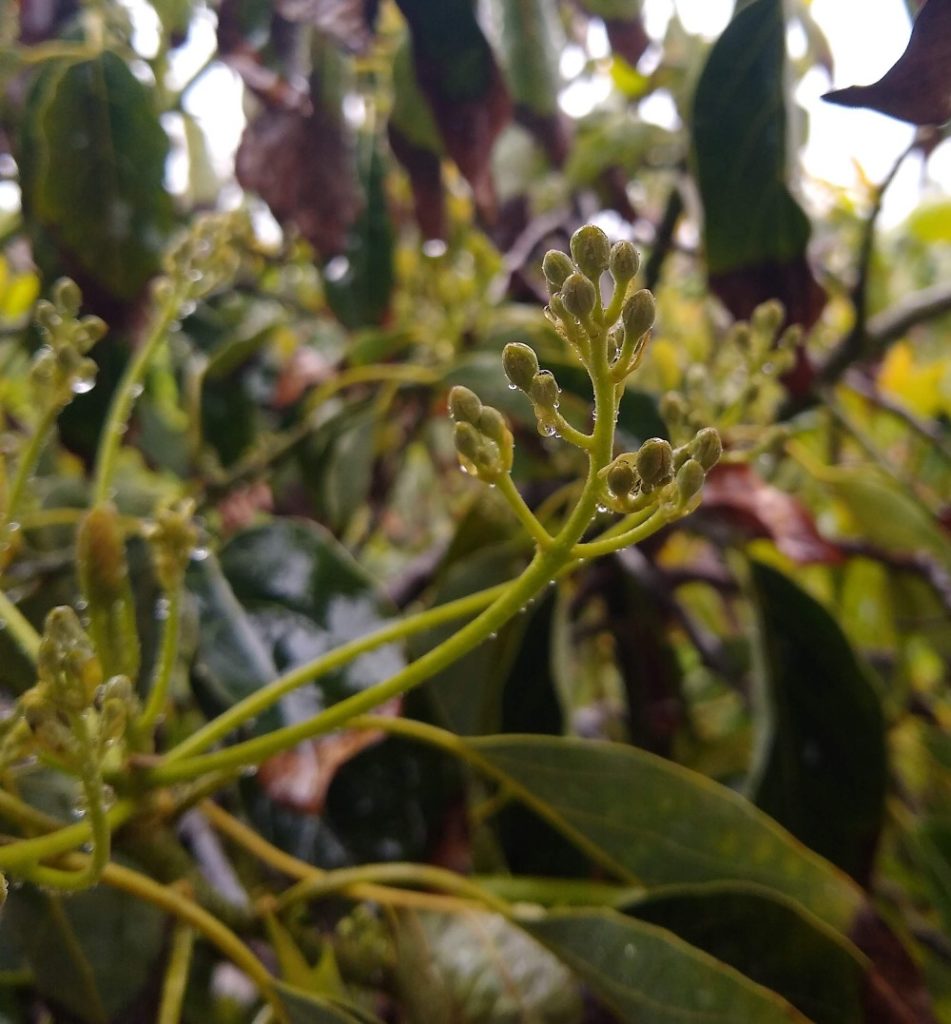
Peach leaf curl is thriving
You know who is in heaven with this weather? The fungus that causes leaf curl in peaches and nectarines, Taphrina deformans. Peaches and nectarine leaves are all puckered up and red, in my yard and everywhere else I’ve seen.
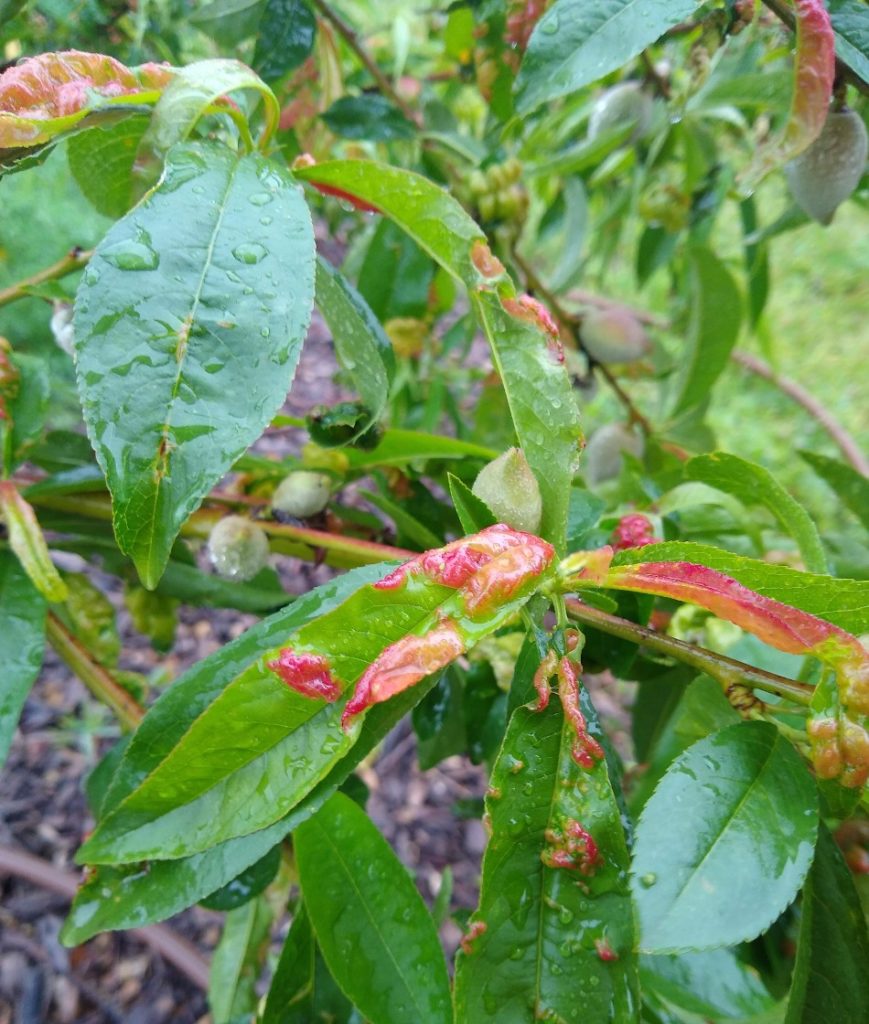
(What can you do about it now? Nothing. But for details see my post, “Dormant spray deciduous fruit trees?”)
So-so growth on warm-season vegetables
When it rains it’s cloudy and therefore cool. The National Weather Service noted that Burbank’s high temperature yesterday (April 9, 2020) was only 52, which is a full 20 degrees below normal. So the vegetables we’ve planted to grow through summer haven’t exactly rocketed in growth. For example, the tomatoes I planted on February 29 are only inching up, just waiting for the normal sun and heat, but they do still appear healthy.
(You might like to see my post, “When to plant tomatoes in Southern California.”)
Super growth on cool-season vegetables
Such weather is hospitable to the leftovers from winter, however. Lettuce is thriving. Carrots are happy. Peas feel like they’re in England. The late cabbage that I planted on February 10 continues to grow large leaves — and with very few aphids on them — and I can see that the heads that form will likely be satisfyingly large as well.
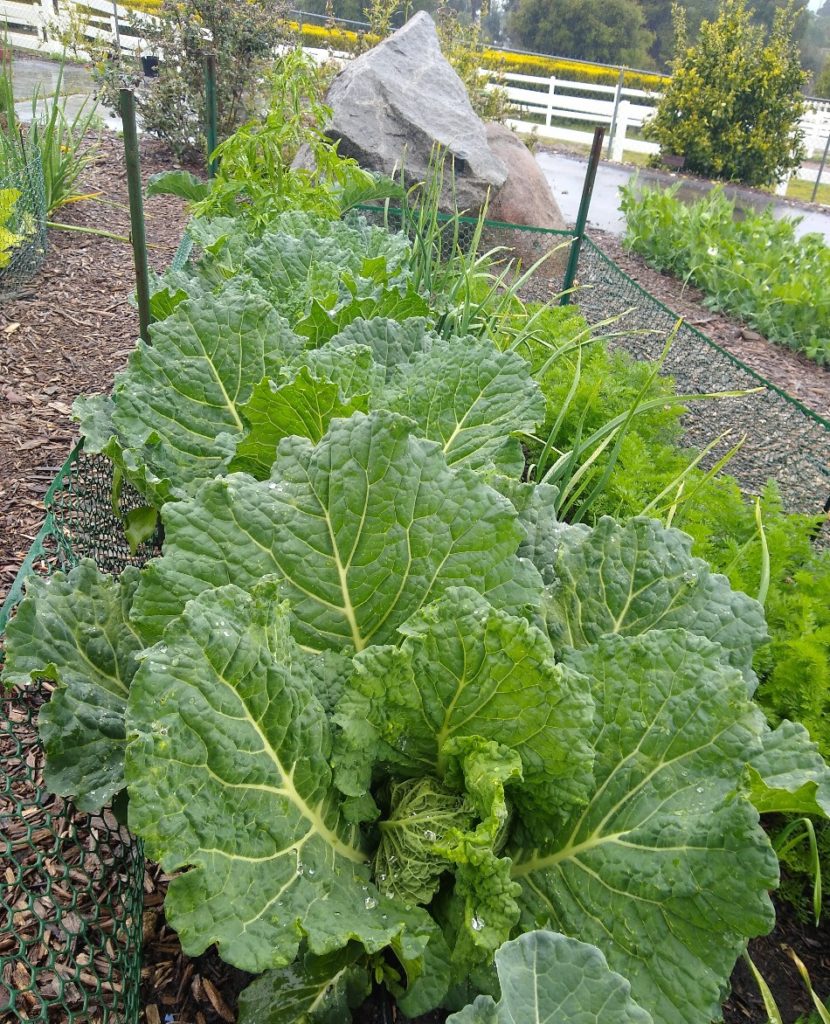
(You might like to see my post, “Growing greens in Southern California.”)
Shortened irrigation season
Who knows if this will be our last real rain for the season? It should be. And if it is, it has already been enough to slightly shorten our irrigation season. While some vegetables might need water again in a week if the weather is dry, some established fruit trees might not need water until beyond June. You might remember that last winter we had many inches of total rain, but the rain stopped in March, practically speaking. (April 2019 only recorded 0.4 inches in my yard for the whole month.) Even then, I didn’t need to water my deciduous fruit trees until early June.
I appreciate the delayed start to our long dry season where the constant irrigation is a necessity for almost all vegetables and fruit trees all the way until rains return, usually around November.
(What if you don’t water? Check out my post, “Unirrigated fruits and vegetables in Southern California, summer 2019.”)
Will this spring get even stranger and storm again though? Will some fruit trees not need water until late June, after summer has officially started? It will be fun to watch the drama of the weather — and caused by the weather — play out.
A list with links to all of my Yard Posts is HERE.

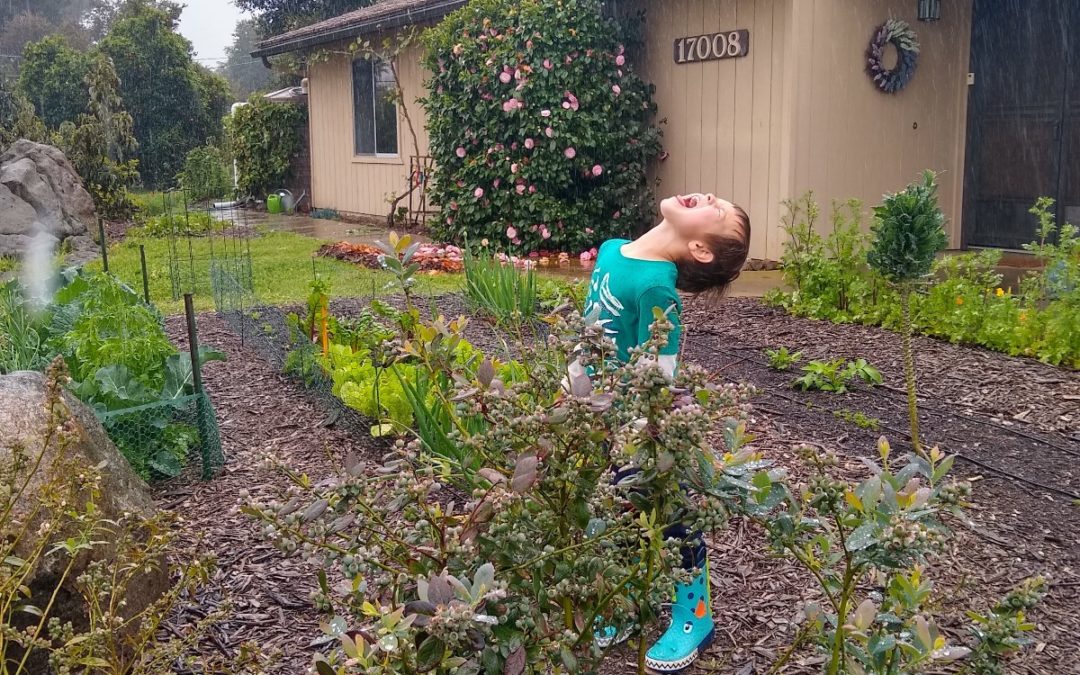


This very wet cool spring has been an excellent time to plant baby avos. I’ve planted 8 #5s, the last one on April 1, a second Sharwil. As I wash off most of the woody potting soil before planting, this cool/wet weather has lessened
planting shock, and given them the perfect rain forest environment! Hopefully when the weather finally turns, it will not jump into the 80s too fast.
Totally agree, Frank. I have not needed to water any of the avocados I’ve planted since early March. This is what we dream of, and what avocados dream of. It’s just too easy this year.
Strange. One week ago I planted three avocado trees from five gallon containers: a Nimlioh, ardith, and a Gwen. They were totally flush with new leaves and looking so nice and perky in the ground. Then today, all three were looking wilty and I got super nervous. I know avocado leaves start to droop when they are overwatered, and I suspected that was the cause. Then today, after some sunshine, they perked up again thank goodness. Not much you can do about overwatering due to heavy rainfall!
Relief! That was the kind of rain that really tests your drainage. If your avocados look good after that, then they’re probably in soil that will keep them happy for the long haul.
But wait, didn’t you give away a small Ardith last year?
Yes, I did but that was a TINY ardith from green scene. I got a good size ardith from Atkins nursery and found it a good home. You know I have growing children and I can’t wait that long for a smaller avocado to grow! I’d much rather start bigger. I continue to rely on your posts and use them as a reference. Such a great community. You’ve built here. And what a good way to wait out the pandemic! Gardening!
Thanks, Keith. I’m so glad you and others contribute because it would be so boring with just my perspective.
I completely hear you on the tiny Ardith. It has been trying to watch the tiny trees that I bought at Green Scene a few years ago grow up because, of course, they are rare varieties that I really want lots of fruit from as soon as possible. In fact, I have taken wood from them and grafted them onto big trees just to get more fruit sooner.
About the kids, my goodness I never planned for how many avocados they would eat! I thought, Oh, maybe some of my kids will like avocados and some won’t, but no. I wish I had planted many more trees many years ago. But don’t we all.
Hi Greg, I have a Pink Lady apple tree that has just not gotten the word to break dormancy. It puts out a spurt here, and another there, and now 1 bloom. The other 7 are moving along AOK. Hope all is good with you. See ya, Robert
Hi Robert,
My Pink Lady apple tree has also not gotten the word. It doesn’t have a single open flower, just some color showing on a few swollen buds. I’m not worried because it’s always one of the last to break dormancy, but it never ceases to make me pause and wonder if it’s healthy. Glad your other trees are looking good.
I’m following your advice to not plant the warm-season veggies too early. And decided to sow some lettuce seeds 6 weeks ago and then add a 6-pack of mixed lettuce. They’re loving the weather. By the time they’re finishing up, we’ll interplant the tomatoes and peppers and be good to go, I hope.
The Encinitas Community Garden is floating from all the rain!
Great to hear, Brian. You have certainly scheduled things right this year. I’m glad I planted my late cabbage in February, but I wish I’d also planted some late broccoli and cauliflower this year. My cauliflower is now done and my broccoli is almost all done. If only I’d known the season would turn out this way.
Hope it’s not flooded there at the Encinitas Community Garden. I know it’s flat and in a bit of a canyon bottom.
Greg. Thank you for sending your posts. They are very informative and interesting. I do appreciate it very much.
Thanks for taking the time to write, Mike. I appreciate it.
As of 4:30 ,,pm here in vista CA
7.56 inches for the week
What! That’s over half of a year’s worth of rain in a single week of spring! Can’t wait to read the list all of the records broken and how the meteorologists put this storm into historical context when it’s all finished.
Thankfully I got a lot of veggies planted this past weekend.
Can I send u pictures,?
Just shy of 7 inches on the week for rain here in Vista. Since Thursday evening until now… almost 4. Good rain!
The entire post is what I’m seeing, too. Here near SDSU my garden keeps popping up weeds, borage, other flowers, etc. We’ve weeded it numerous times. The only relatively weed free places are where the chickens are. Peach leaf curl is really bad this year but there’s a wonderful tradeoff…virtually all of my stone fruits are producing, even the high chill ones. There’s a couple of trees here that have been in the ground for five years and nothing, but this year they’re full of flowers and plenty of fruit to thin. I’m not certain but I would argue that this late winter/early spring is colder than last years (and last year was pretty cold), which is why I think I’m seeing some of my trees bloom that never really have done much.
Tomato seedlings I seeded in late February aren’t looking too hot but the lettuce, spinach, etc I seeded over a month ago when the pandemic took off are doing pretty well. We’re probably going to be starting in on salads from those next week. As for avocados, my lamb hass which looked like it was going to die last year looks the best it has in probably three years with tremendous new growth. Thank you for the great post.
Interesting happenings, Bob. I have heard people say that the important chill time for deciduous fruit trees is in the early period of dormancy, like late fall and early winter — November and December, maybe January. And this season we got hit by that first rain just before Thanksgiving and it was consistently wet and cool until Christmas.
Then when the rains stopped it didn’t warm up. Even though January was relatively dry, it was chilly. My yard barely broke 70 on four days in January. Nights were all full of chill.
That all seems like ideal conditions for those trees you’re seeing bloom better than ever. Maybe?
Great post “Peas feel like they’re in England.” ha! Love your writing… I had 7.6 inches from this storm in La Costa! Great gardening weather ahead. Stoked!
Thanks, James. How’s your drainage? Puddles in the yard? That’s a lot of water!
Hey Greg,
Great post! Yeah, my Sir Prize has just opened a few flowers. Hass’ flowers are still closed, though its leaf growth looks great.
Thanks! Good to know, Jim. I would have expected your trees to be far ahead of mine in flowering because of your warmer location.
Posted in the wrong spot (unirrigated plants of 2019) reposting here. Revisiting this read after our latest rounds of rain here in December 2021. At the rate we’re going, will not need to water until January. I’m all mulched up, but am wondering after the rain stops, when to water again. I’ll be poking the soil moisture meter in the ground to figure out when to water next. I’m have mostly 4 year old avocado trees, at what moisture depth would I want to start watering again in January (assuming we dont get more rain, fingers crossed we do:) On a hillside in Whittier